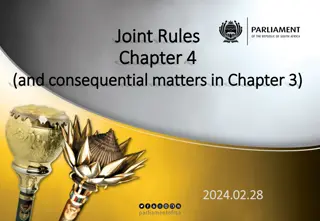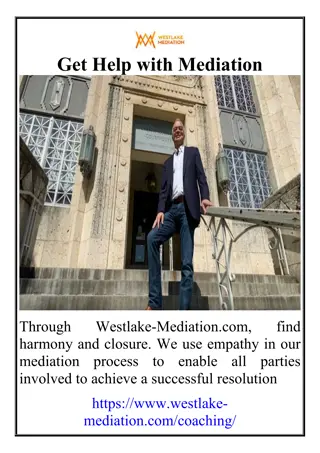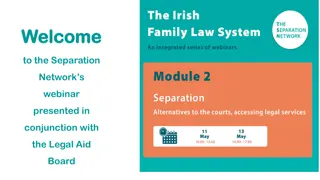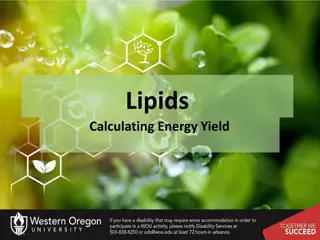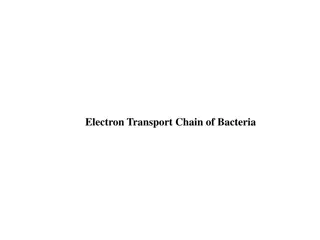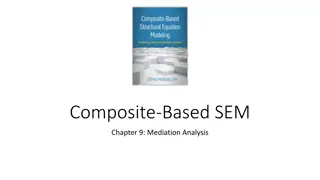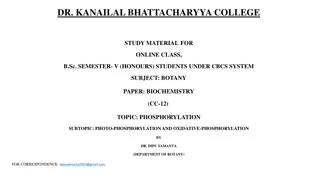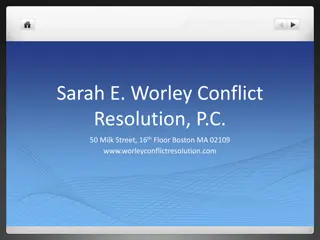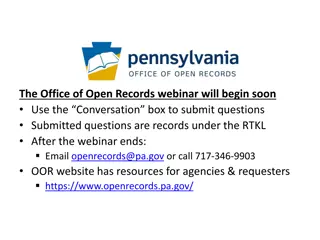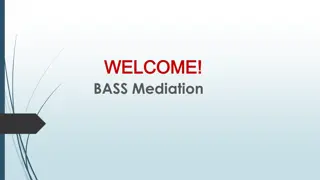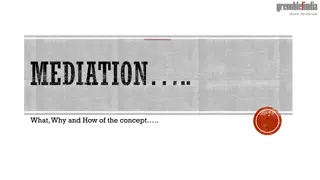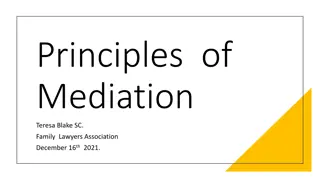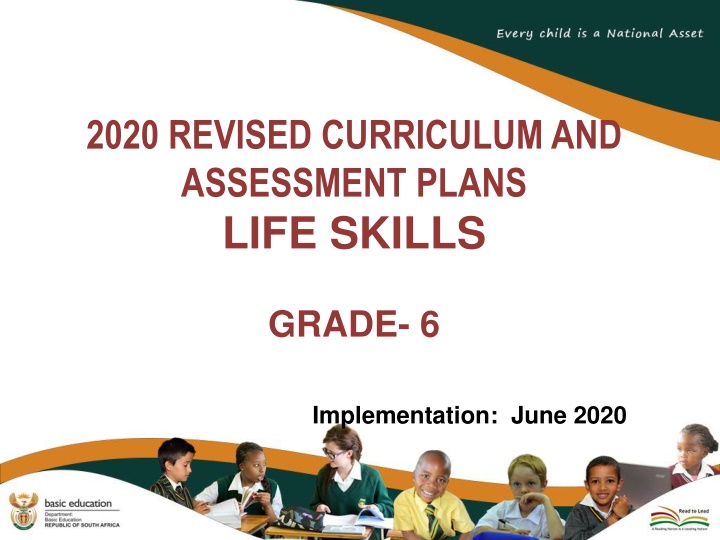
Implementing Revised Curriculum & Assessment Plans for Grade 6 Life Skills
Explore the purpose and key amendments to the 2020 curriculum and assessment plans for Grade 6 Life Skills, focusing on enhancing teaching content, assessment strategies, and learner preparation for the following year. Amendments cover topics like personal strengths, hygiene principles, emotions, bullying, self-esteem, peer relationships, and problem-solving skills.
Download Presentation

Please find below an Image/Link to download the presentation.
The content on the website is provided AS IS for your information and personal use only. It may not be sold, licensed, or shared on other websites without obtaining consent from the author. If you encounter any issues during the download, it is possible that the publisher has removed the file from their server.
You are allowed to download the files provided on this website for personal or commercial use, subject to the condition that they are used lawfully. All files are the property of their respective owners.
The content on the website is provided AS IS for your information and personal use only. It may not be sold, licensed, or shared on other websites without obtaining consent from the author.
E N D
Presentation Transcript
2020 REVISED CURRICULUM AND ASSESSMENT PLANS LIFE SKILLS GRADE- 6 Implementation: June 2020
Presentation Outline 1.Purpose 2.Amendments to the Content Overview for the Phase; 3.Amendments to the Annual Teaching Plan; 4.Amendments School Based Assessment (SBA) 5.Conclusion
1. Purpose To mediate the amendments of the trimmed and re-organised 2020 Annual Teaching Plan including School Based Assessment for Life Skills, Grade 6 for implementation in June 2020 as stipulated in Circular No S2 of 2020. To ensure that meaningful proceeds during the remaining teaching time as per the revised school calendar. To assist teachers with guided pacing and sequencing of curriculum assessment. teaching content and
1. Purpose (continued) To enable teachers to cover the essential core content /skills in each grade within the available time. To assist teachers with planning for the different forms of assessment. To ensure learners are adequately prepared for the subsequent year/s in terms of content, skills, knowledge, attitudes and values
2. Amendments to the Content Overview for the Phase
Summary: Amendments to the Content Overview for the Phase Key Topic Grade: 4 Grade 5 Grade 6 Personal strengths Respect for own and others bodies Basic hygiene principles (issues of COVID-19) Emotions: understanding a range of emotions Personal experience of working in a group Bullying: appropriate responses to bullying Positive self- concept formation Receiving and giving feedback Coping with emotions Relationships with peers, older people and strangers Positive self-esteem: body image Abilities, interests and potential Peer pressure Problem solving skills in conflict situations Self-management skills (Hands washing, wearing mask, sanitize Social/ Physical distancing, regular cleaning of your work station). Bullying: getting out of the bullying habit Development of the self
Summary: Amendments to the Content Overview for the Phase Key Topic Grade: 4 Grade 5 Grade 6 Basic hygiene principles (issues of COVID-19) Basic first aid in different situations Communicable diseases including COVID- 19 Food hygiene Basic hygiene principles (issues of COVID-19) Safety measures at home and the environment Water as an important basic need Healthy eating for children Local environmental health problems HIV and AIDS education: dealing with stigma Substance abuse Basic hygiene principles (issues of COVID-19) Dangers in and around water: home and public swimming pools, rivers and dams Traffic rules relevant to road users: pedestrians and cyclists Personal and household hygiene Dietary habits of children Healthy environment and personal health: home, school and community HIV and AIDS education: basic facts Risks of COVID -19 on people with chronic diseases Transmission of the virus- COVID 19 Health and environmental responsibility HIV and AIDS and COVID-19 education: myths and realities Risks of COVID -19 on people with chronic diseases Transmission of the virus- COVID 19
Summary: Amendments to the Content Overview for the Phase Key Topic Grade: 4 Grade 5 Grade 6 Basic hygiene principles (issues of COVID-19) The dignity of the person in a variety of religions in South Africa Cultural rites of passage Caring for animals Caring for people Nation-building and cultural heritage Gender stereotyping, sexism and abuse Basic hygiene principles (issues of COVID-19) Concepts: discrimination, stereotype and bias Child abuse Dealing with violent situations Issues of age and gender Festivals and customs of a variety of religions in South Africa Basic hygiene principles (issues of COVID-19) Children s rights and responsibilities Cultures and moral lessons Knowledge of major religions in South Africa: Judaism, Christianity, Islam, Hinduism, Buddhism, Baha i Faith and African Religion Closing of places of worship during lockdown New norm when places of worship re- open Social responsibility - -
Summary: Amendments to the Content Overview for the Phase Grade: 4 Key Topic Grade 5 Grade 6 Participation in rhythmic patterns of movement with co- ordination and control. Participation in rhythmic movements with focus on posture. Participation in rhythmic movements with focus on posture and style. Safety measures during rhythmic movements. Safety measures relating to rhythmic movements. Safety measures relating to rhythmic patterns of movement. Physical Education Movement performance in rhythmic movements with focus on posture. Movement performance in rhythmic movements with focus on posture and style. Movement performance in rhythmic patterns of movement with coordination and control.
Summary: Amendments to the Content Overview for the Phase Grade: 4 Key Topic Grade 5 Grade 6 Participation in refined sequences emphasising changes of shape, speed and direction or swimming activities. Safety measures relating to sequenced movement activities. Participation in basic field and track athletics or swimming activities. Participation in a variety of field and track athletics or swimming activities. Safety measures during athletic or swimming activities. Safety measures during field and track athletics or swimming activities. Physical Education Movement performance in basic field and track athletics or swimming activities. Movement performance in a variety of field and track athletics or swimming activities Movement performance in refined sequences emphasising changes of shape, speed and direction or swimming activities
Summary: Amendments to the Content Overview for the Phase Creative Arts: Visual Art Themes interpreting the personal and social world using 2- dimensional techniques that encourage manipulation of media, colour mixing, and problem-solving. Grade: 4 Grade 5 Grade 6 Extend themes to include local environment; develop techniques. Extend to include national environment; further develop use of media and techniques. Formal introduction to complementary colour, develop use of all art elements. . Formal introduction to monochromatic colour, further develop use of all art elements. Art elements: formal teaching of the art elements, such as line, shape, secondary and related colour, tints and shades. Topic 1: Create in 2D Introduce emphasis and further develop use of design principles. Introduce conscious use of balance, and further develop use of design principles. Design principles: formal teaching of contrast and proportion. Lettering and/or pattern- making projects as surface decoration. Lettering and/or pattern- making: include radiating patterns; awareness of composition. Creative lettering and/or pattern- making projects: shape, line, colour, texture, drawing, cutting and sticking shapes in series.
Summary: Amendments to the Content Overview for the Phase Creative Arts: Visual Art Grade 6 Grade: 4 Grade 5 Themes interpreting the personal and social world using 3- dimensional techniques that encourage manipulation of media and awareness of shape in space. Art elements: texture, shape/ form and colour. Design principles: contrast, proportion. Skills and techniques for 3D work Use of tools: safety, consideration of others, shared resources. Concern for the environment: use of recyclable materials. Extend to include local environment; develop techniques; deepen awareness of personal use of space Increase conscious use of all art elements. Introduce emphasis and further develop use of design principles. Care of tools. Awareness and value of recycling. Extend to include national environment; further develop use of media and techniques; properties of 3-dimensional work Deepen and extend conscious use of all art elements. Introduce conscious use of balance, and further develop use of design principles. Responsibility for shared space and tidiness. Intentional choice of recyclable materials. Topic 2: Create in 3D
Summary: Amendments to the Content Overview for the Phase Creative Arts: Visual Art Grade: 4 Grade 5 Grade 6 Develop visual literacy: encourage understanding of own world by expressing in words: description ofown and others artwork, visual stimuli, popular culture and famous artworks; incorporate art elements and design principles. Introduce local environment and deepen awareness of art elements and design principles in visual stimuli. Introduce national environment and extend range and observation of art elements anddesign principles: contrast, proportion, emphasis, balance and unity. Topic 3: Visual Literacy Apply and identify in ownwork Apply, identify and personally interpret in own work Apply learning to own work
Summary: Amendments to the Content Overview for the Phase Creative Arts: Performing Arts Revision and consolidation of Terms 1-3 Physical warm up and relaxation exercises. Vocal/singing warm ups. Posture/ concentration/ focus/ trust and listening games. Clapped rhythms and body percussion in unison and canon songs. Rhythm/Musical games (contrasting rhythm patterns, number songs and rhymes) Cool downs. Grade: 4 Grade 5 Grade 6 Revision and consolidation of Terms 1-3 Physical warm ups for strength and flexibility (including spinal rolls). Vocal warm ups (including strengthening articulation through rhymes and tongue twisters). Posture/ concentration/ focus/ trust and listening games. Call and response games. Singing warm ups (traditional & SA songs: unison, canon, two- part harmony, call and response) Cool downs. Revision and consolidation of Terms 1-3 Physical warm up and relaxation exercises (spinal warm up, body part isolations, floor work, knee bends and rises, jumps and leaps, flexibility, etc.). Vocal/singing warm ups (breath control exercises, etc.) Posture/ concentration/ focus/ trust and listening games. Singing warm ups (traditional & SA songs: unison, canon, two- part harmony, call and response) Cool downs. Topic 1: Warm up and play
Summary: Amendments to the Content Overview for the Phase Creative Arts: Performing Arts Locomotor and non-locomotor movements. Grade: 4 Grade 5 Grade 6 Movement responses to sound pictures / different types of music. Short dialogues/ movement sequences/ musical pieces exploring conflict. Movement responses to sound pictures / different types of music. Short music piece, combining a number of instruments including two or more parts in a textural blend, reflecting a mood related to the social, cultural or environmental issue. Short story inspired by listening to a piece of music. Mime using imagery objects, etc. Topic 2: Improvise and create Physical shapes using gesture, etc. Short dialogues/ movement sequences/ musical pieces exploring conflict. Tableaux (frozen pictures) in response to locations/themes. Mime actions using the five senses. Rhythm patterns of different note values using body percussion and/or percussion instruments. Movement sequences using elements of dance and combinations of movements. Short Dance/Drama improvisation reflecting a mood related to a social, cultural or environmental issue. Sound pictures, melodies and rhythms, to enhance the mood of tableaux. OPTIONAL: PUPPETRY
Summary: Amendments to the Content Overview for the Phase Creative Arts: Performing Arts Grade: 4 Grade 5 Grade 6 Building a drama from a stimulus. Short Dance/Drama presentation reflecting a mood related to a social, cultural or environmental issue use short piece of music in above presentation. Integrated performance by selecting a ritual/ceremony/ dance. Create a soundtrack using body percussion/self-made instruments for the drama (consider dynamics, pitch, timbre and tempo). Topic 3: Read, interpret and perform OPTIONAL: PUPPETRY
Summary: Amendments to the Content Overview for the Phase Creative Arts: Performing Arts Grade: 4 Grade 5 Grade 6 Reflect on own and other s performances and processes. Reflect on own and other s performances and processes. Reflect on own and other s performances and processes. Use simple CA terminology. Use simple CA terminology. Use simple CA terminology. Topic 4: Appreciate and reflect Reflect on two different types of SA dramas/cultural rituals and ceremonies/ dances/music. Reflect on two different types of SA dances/ music (Pop, Kwaito, and Traditional, etc.). Reflect on two different types of SA dramas/cultural rituals and ceremonies/ dances/music.
3. Amendments to the Annual Teaching Plan
Summary: Reorganisation of content topics Content within which Covid-19, hygiene, and psychosocial issues can be infused then brought forward to Term 2; Hygiene principles integrated within the content wherever possible; Covid-19 issues integrated within the content wherever possible; Self-management and self-study skills integtarded within the content wherever possible;
Summary: Reorganisation of content topics Content within which Covid-19, hygiene, and psychosocial issues can be infused then brought forward to Term 2; Hygiene principles integrated within the content wherever possible; Covid-19 issues integrated within the content wherever possible; Self-management and self-study skills integrated within the content wherever possible;
Summary: Amendment to the weighting of content topics The subject is allocated time according to the content topics for term two, three and four for 2020 academic year A portion of other topics was dealt with in term one Other content is not going to be dealt with in depth
Summary: Content/Topics Amended Health and Environmental Responsibility: Communicable diseases such as mumps, tuberculosis, common colds, chickenpox, athletes foot, etc. Content/Topics Term Amendment Content relevant to address the Covid_19 because pandemic could be easily infused in the topic. The content has been moved from term 4 weeks 5-7 to term 2 week 1- 2 Health and Environmental Responsibility Food hygiene: Safe and harmful ingredients The content has been moved from term 4 weeks 2-4 to term 2 week The content is relevant to the Covid-9 issues. Health and Environmental Responsibility HIV and AIDS education: myths and realities about HIV and AIDS including risks and perceptions about HIV and AIDS The content has been moved from term 4 week 8 to term 2 week 5- 6 The content is relevant to the Covid- 19 issues.
Summary: Content/Topics Amended Content/Topics Term Amendment The content has been moved from term 2 weeks 3-4 to term 3 weeks 1- 2 Development of the Self Bullying: reasons for bullying Getting out of the bullying habit: where to find help Term 2 content which is relevant in helping learners deal; with COVID- 19 has been moved to the 3nd term. This resulted in the content of term 3 moving to the other terms The content has been moved from term 3 weeks 8-9 to term 4 weeks 2 - 3 This content would taught in term 4 weeks 2-3 in the place of food hygiene that has been moved to term 3 weeks 8-9. Social Responsibility Gender stereotyping, sexism and abuse: definition of concepts Effects of gender stereotyping and sexism on personal and social relationships
Summary: Content/Topics Amended Content/Topics Term Amendment The content has been moved from term 2 weeks 5-7 to term 4 weeks 4 -5 This content would taught in term 4 weeks 4 -5 in the place of Communicable diseases that has been moved to term 2 weeks 5-7 to strengthen the awareness of Covid 19. Social Responsibility Cultural rites of passage: Important stages in the individual s life in South African cultures: birth, baptism, wedding and death Meaning of each stage Personal and social significance of each stage The content has been moved from term 2 weeks 8-9 to term 4 week 7 This content would taught in term 4 weeks 7 in the place of HIV Aids that has been moved to term 2 weeks 8-9. (Effects of Covid -19 on people who are HIV positive. Social Responsibility The dignity of the person in a variety of religions in SouthAfrica
Creative Arts Summary: Amendments TERM 2: Visual Art to be taught during the very challenging Term 2 when schools are settling and finding ways to spilt classes/reorganise timetables to ensure social distancing. Only informal formative assessment takes place. TERM 3: Only (teach) focus on Visual Art for Formal Assessment. Approximately 7 lessons for Visual Art for Grades 4, 5 and 6. Periods will most likely be shortened to account for spilt classes. It is most likely that less time would be allocated to Creative Arts, therefore the extra time of Term 2, especially for the Grades 6s would be useful. TERM 4: Only (teach) focus on Performing Arts for Formal Assessment. Approximately 7 lessons for Performing Arts for Grades 4, 5 and 6. Schools would have most likely have settled and Performing Arts would therefore be a more appropriate choice. It is hoped that the COVID curve has flattened by end September / October so that normal classes can continue affording the full 90 minutes per week for Performing Arts to make up for lost time.
Summary: Content/Topics Amended Art Streams Term Amendment Term 4 content integrated into the content of Term 2 and Term 3. Term 4 content will be replaced with the content on Performing Arts (in Term 4). Visual Art Performing Arts will be taught in Term 4. Term 2 and 3 content reduced and integrated in content of Term 4. Performing Arts: Music, Drama, and Dance Visual Arts will be taught in Term 2 and Term 3.
Summary: Amendment to the weighting of content topics Grade 4 Grade 5 Grade 6 Study Area Hours Hours Hours Personal and Social Well- being 26 28.5 33.5 Physical Education 14 14 14 Creative Arts 24 25.5 28,5 Contact Time 64 68 79 Written Task and PET 6 6 6 Total Hours 70 74 79 Total Weeks 16 18 20
4. Amendments School Based Assessment (SBA)
Summary: Revised Programme of Assessment
Summary: Revision Final Examination Structure No mid-year and final examinations will be administered throughout the remaining terms.
Summary: Physical Education Task (PET) Physical Education will only take place in Term 3 and 4. The Social Distancing Guidelines on adhering to COVID-19 regulations will need to be used and followed for Physical Education.
Summary: Revised Creative Arts Assessment Task (CAT) Participation in both streams will be assessed informally through class observation in each term. Visual Arts CATs (formal assessment) can take the form of any creative task which takes a minimum of 3 periods to complete. Performing Arts CATs (formal assessment) can be taken from any of the tasks in Topics 2 or 3 for the term, which combine the use of at least TWO of three art forms. The Social Distancing Guidelines on adhering to COVID-19 regulations will need to be used and followed for Performing Arts.
Conclusion Grade 6 learners completed Term 1 in 2020 of schooling before COVID-19 forced the closure of schools; The ATP will be implemented during Term 2 on the opening of schools; COVID-19 issues were included in the ATP to conscientise learners on the pandemic gripping the whole world; and Self-management (self-study skills) and preparation of learners to deal with grief and emotions etc. are dealt with in the ATP.
Contact Details Name: CES: Jerry Zitha Department of Basic Education Tel: 012 357 3685 Email: Zitha.J@dbe.gov.za

